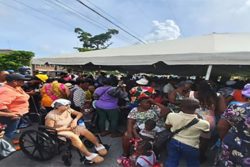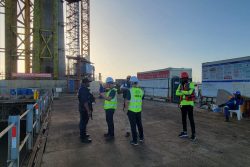There is a buzz in the air about local tourism. There was Prime Minister Mark Phillips turning the sod for the construction of a Hospitality and Tourism Training Institute in Port Mourant earlier this year, saying that the government was working to create 50,000 jobs in the tourist industry by 2030. For his part Finance Minister Ashni Singh during the Budget debate in January said that Guyana was on the cusp of becoming a leading sustainable tourism destination, and that this year the government was poised to make historic developments in the sector.
The Guyana Tourism Authority is not lagging behind, hosting business licensing clinics, which have been attracting ever more businesses and guides, the public was told. In March we reported on the agency’s promotion efforts and the fact it was focusing on resurrecting and rehabilitating existing tourism-related infrastructure as well as expanding on what already exists. In addition to interior locations, it was said, there was also a greater level of attention being paid to coastal facilities, especially where suitable accommodation for visitors was concerned. Among its other ventures it was committed to “promoting Guyana as a premier tourist destination on the global stage.”
Interior tourism is what it has been traditionally assumed would constitute the biggest attraction for overseas visitors, although this could never take the form of mass tourism; neither the environment nor the population could sustain anything remotely close to that. While the government has emphasised sustainability, one hopes they ensure this principle is rigorously adhered to. Furthermore, hinterland tourism should be in the hands of the indigenous people themselves, so they do not become ‘objectified’ as part of a tourism package devised by purely coastal players.
It is on the coast, however, that hotels appear to be proliferating, possibly partly with a view to accommodating foreign workers in the oil industry, although it is also with the aim of attracting tourists. Traditionally it has been members of the Guyanese diaspora who have formed the backbone of our tourist industry such as it was, and although they will still come the campaigns of the Tourism Authority seems to be directed towards overseas visitors in general. But the interior aside, what will they come and see?
Tourists don’t come to see a physical environment which looks very similar to the one they have at home, and individuals as well as governments here have a penchant for destroying the traditional building style which was unique to this country, and replacing it with the pedestrian modern architecture characteristic of small-town North America.
Governments have been particularly cavalier about preservation, allowing buildings of national importance to be vandalised and then crumble into dust, such as the New Amsterdam Hospital and the Palms, and failing to have to have the kinds of arrangements in place which might have saved old structures in private hands like the Psaila house in Main Street. It took many years, for example, before the current government finally provided the funds to rescue City Hall.
Our attitude to historic buildings has contrasted with that of Suriname, which has three sites on the World Heritage List, one of which is the historic city centre of Paramaribo. This has given its remarkable architectural heritage international recognition, and created possibilities for access to funding for conservation and protection. Before a site can be inscribed on the World Heritage List, the country has to be a party to the World Heritage Convention, which Suriname clearly is, but interestingly, so is Guyana. We became signatories as long ago as 1977. There are, of course, provisions and guidelines attached to World Heritage List status, which if not complied with could lead to sites being placed on the ‘hazard list’ or completely removed from the list altogether.
In the World Heritage Committee’s decision to place Paramaribo on the List, it was stated, among other things, that the city “is an exceptional example of the gradual fusion of European architecture and construction techniques with indigenous South American materials and crafts to create a new architectural idiom.” Although it is true that Paramaribo is much older than either Georgetown or New Amsterdam, nevertheless what was said of the Suriname capital was once equally applicable here. It is just that we have demolished so much of our “new architectural idiom,” that Georgetown in particular no longer looks the same as it once did.
Despite that, there are historical dimensions of our capital which can be rescued from oblivion. Around twenty years ago Dr Ron van Oers came here after having worked on the listing of Paramaribo, and he pointed out something which nobody here had alighted on before: that Georgetown was the only plantation city in the world. Historians knew that it had evolved on the frontlands of the lower Demerara plantations, but had never quite thought of it in those terms. This was around the time that the government had renewed plans to destroy Bourda cemetery by driving a road through it, following in the footsteps of a series of governments and city councils dating as far back as 1962.
Dr Van Oers’ suggestion was to create a plantation walk, which would encompass, among other things, City Hall, which it is thought stands on the site of Plantation Bourda’s cotton logie and then a stroll down Regent Street, which was the middle walk of the plantation. The orange and citrus grove of the estate is recalled in Orange Walk, and the private graveyard of the plantation is Bourda cemetery. In addition, the top portion of the gap between Bourda and the neighbouring plantation still exists in the form of Company Path. The Dutch authorities required there should be a space of certain dimensions between estates which were to be planted with plantains and the like, and these were known as Company Paths.
There are all kinds of possibilities for exploring the past of the city which would not just be of interest to tourists, but more important, to local inhabitants as well. All it requires is a bit of imagination and a knowledge of history, neither of which is much in evidence nowadays. In particular all governments from the PNC onwards have been very derelict in their duty with respect to museums and museum policy. How is it, when this country was once the largest sugar producer in the anglophone Caribbean, there is no sugar museum? Why are there no plantation compounds visitors can go to, complete with plantation houses and the contrasting logies?
Why is there not a general plantation museum in Berbice, say, where for much of the eighteenth century coffee, cotton and cacao were grown? And what about something, somewhere, on local technology? This does not require actual physical examples, which will have mostly been destroyed here, but virtual displays of how sugar was processed, etc, some of which can be based on what is done currently. And what about a small gallery of historical pictures, so tourists and locals could see what the country was once like. There are no end of possible feasible ideas which could be explored. Perhaps the Guyana Tourism Authority needs to be a bit more adventurous in its thinking, and the Guyana Government more open to suggestions beyond roads and related infrastructure.








